
| welcome | ||||||||||||||
| history | ||||||||||||||
|
||||||||||||||
| reconstruction | ||||||||||||||
| today | ||||||||||||||
|
||||||||||||||
| links | ||||||||||||||
| about this site |



The Vitruvian man has been used both as an image in art, and as an image representational of "the arts".
The Vitruvian Man has been appropriated by many an artist, with widely differing
intentions. For instance, William Blake seeks to let the Vitruvian man free
in “Glad Day”, whereas Andrew Leicester’s “Tin Man”
emphasizes man’s mechanical nature. Nat Krate creates a “Vitruvian
Woman” to stand alongside the Vitruvian Man.
One of the earliest appropriations of the Vitruvian Man in art is William Blake’s 1795 “Glad Day.” In this striking picture, the Vitruvian Man is set free of its constraining circle and square, and is infused with new dynamism and joy. As stated in The Independent (13 Aug 2000), in this painting, “Blake takes this diagrammatic figure and converts it into a god of energy, makes its static pose a centrifugal fling.”
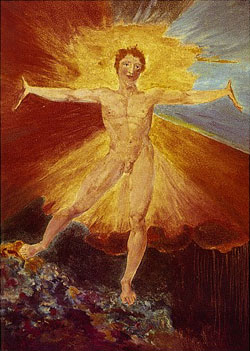 |
Blake felt that ideal forms should be constructed not from observations of
nature, but from inner visions. He continually stressed imagination over reason;
it is hence somewhat ironic that he should adapt a work by Leonardo, who was
so focused on observation and the measurement of proportions.
To find out more about Blake, click
here.
The towering “Tin Man” sculpture stands in the University of Minnesota’s engineering courtyard. Andrew Leicester, a sculptor from Minneapolis, designed this 6,000 pound sculpture as a tribute to the Vitruvian Man.
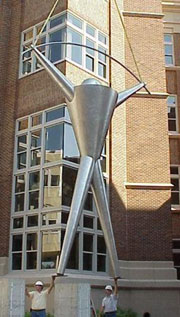 |
| source: Uwe Kortshagen |
In stark contrast to “Glad Day” (above), the massive robot-like
sculpture emphasizes the mechanical nature of man, and, as Mechanical Engineering
professor Steven Girshick says, the figure evokes "a vaguely humorous
feeling that emanates from the robot-like appearance, expressing our ambivalence
about the ever-increasing role of technology in our lives."
The Vitruvian Man is said to express the sentiment that “man is the measure
of all things.” What is this massive sculpture expressing about our current
conception of that sentiment?
For more pictures of the tin man, click
here.
Nat Krate has made a fascinating image of the “Vitruvian Woman” in the tradition of Leonardo’s drawing. Although Krate’s work has been criticized as “too academic” in his execution of the body (Mary Ann Marger in St Petersburg Times, 29 Sept 1989), in the case of reproducing Leonardo, his careful attention to the lines, proportions, and shading of the body serves him well.
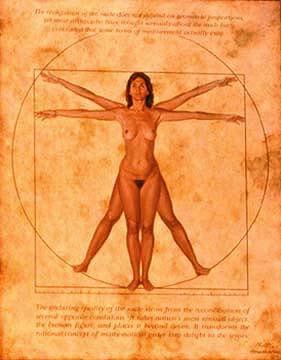 |
| source: Zenith Gallery |
Many of Krate’s works (some images available here) reveal a particular attention to the lines and forms of the female body. However, we have been unable to find any particular statements or criticism about this work, so it is difficult to know just where Krate is coming from. Is he saying that woman is the measure of all things? Merely pointing out that the Vitruvian Man is a man? Paying homage to Leonardo as one who studied the proportions of the body as carefully as Krate himself does? Chastising Leonardo for his androcentric view? Or perhaps just adding another work to his collection of feminist-themed art?
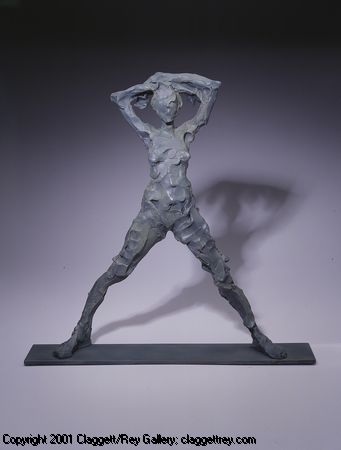 |
| source: ClaggetRey.com |
City Square Associates is a consulting firm that claims to "bring the perspective of the arts and humanities to the practice of research and consulting." They use the Vitruvian Man prominently on their website, suggesting that he embodies these "arts and humanities."
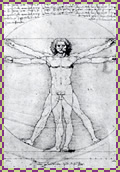 |
| source: City Square Associates |
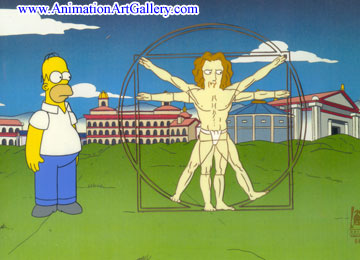 |
| source: Animation Art Gallery |
In the Season 10 episode "Mom and Pop Art" (April 11, 1999), Homer becomes a conceptual artist, creating striking "outsider art" (a tipped-over barbeque, a chainsaw punched through a table...). While in the Springsonian Museum with Marge looking for inspiration, he falls asleep and dreams:
...of waking up in Rousseau's "The Sleeping Gypsy" when the
lion
licks his head. Da Vinci's universal man rolls over to punch and kick Homer.
Picasso's three musicians shoot Homer with machine guns. Then one of Dali's
clocks drips on him. Andy Warhol himself starts throwing cans of soup at
Homer and is about to throw a massive can at him... (source: The
Simpsons Archive)
It seems that the Vitruvian Man has made it through the Simpson's creators' "most famous art" filter.